The X Button
Battle Mania
by Todd Ciolek,

This week sees me reviewing Super Robot Taisen OG Saga: Endless Frontier, a game rife with the sort of puerile lewdness that casts an unflattering light on anime, anime-influenced games, and the people who play them. I'm sometimes conflicted about these things. They're laughable twaddle aimed at teenagers and deprived adults, and yet I also remember what it was like to be 14, when even the idea of cartoon sexuality was compelling. And since your teenage years are largely about doing stupid things that you'll regret when you're older, who am I to stop today's young RPG fans from digging into something like Endless Frontier?
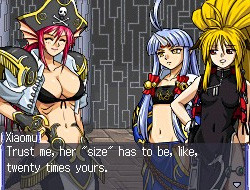
I can still make fun of it, though. When faced with the above, I prefer the defense of mockery to simply curling up into a ball and sobbing.
NEWS
SUPER ROBOT WARS BRINGS FORGOTTEN '90S ROBOT SHOWS TO THE WII
Yes, it's another strategy-RPG from the Super Robot Wars series (technically known as Super Robot Taisen in North America) that we will never play in English, but here's the catch: it's for the Wii, and it's full of fairly obscure shows that are new to the whole Super Robot Wars anthology deal. Super Robot Wars Neo is something of a follow-up to the GameCube's Super Robot Wars GC, in that both have 3-D visuals and noticeably resist the franchise's tendency to draw mostly from popular robot shows. Super Robot Wars GC sprinkled the usual Gundam lineup with some obscure choices (it had Baxinger, of all shows), and Neo takes that idea even further.
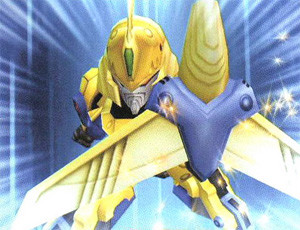
Let's consider the lineup for Neo. G Gundam, Mazinger Z, and Great Mazinger are the big names here, and they've all been in Super Robot Wars titles before. Also returning are Sengoku Majin GoShogun, Ginga Senpuu Braiger, and Zettai Muteki Raijin-Oh, though they aren't as well-known. The rest of the shows represented are seeing Super Robot Wars exposure for the first time: New Getter Robo, Genki Bakuhatsu Ganbaruger, Iron Leaguer, NG Knight Lamune & 40 (pictured at right), Jushin Liger (aka Bio Armor Ryger), Lord of Lords Ryu Knight, Nekketsu Saikyo Gozaurer, and Kanzen Shouri Daiteioh.
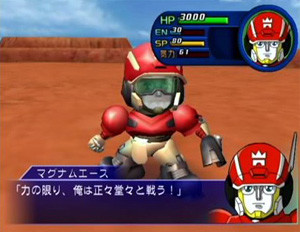
Most of the newcomers are unfamiliar to modern anime fans, and these lesser-known selections hail from the early-to-mid 1990s. This was yet another age when Sunrise churned out lots of kid-oriented robot shows that, dare I suggest it, were perhaps just a tad more concerned with selling toys than enduring as classics of animation (granted, the Daiteioh anime didn't sell too many toys, since it exists only as a pilot episode). It's a gutsy move on Banpresto's part, and it gives Neo a largely new cast for even the dedicated giant-robot fans. The change will do everyone good. Besides, look at Iron Leaguer (left). It's a sports robot show.
I'm a vague Super Robot Wars fan at best, and even I prefer a roster of fresh no-name robots to the same old mecha staples. Besides, the fans of “serious” robot shows won't have to wait long at all for another Gundam-laden Super Robot Wars.
PERSONA PSP PORT COMING IN SEPTEMBER
The original Persona had a rough localization when it arrived on the PlayStation back in 1996: the setting was changed from Japan to America, characters changed their skin colors, and an entire subquest was cut. Atlus is going out of its way to make sure everyone knows that the upcoming PSP port of Persona will have a faithful translation when it arrives here in September.
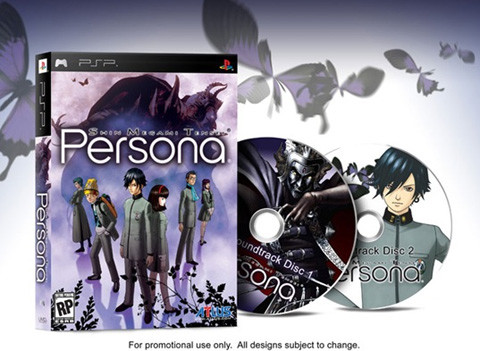
The perhaps-not-final cover of Persona shows the original character art, and one of the screens of the English version even mentions the Snow Queen subquest yanked from the old PlayStation game. As you can see, it also includes a two-disc soundtrack, twice the usual one-disc Atlus bonus.
NARUTO SHIPPUDEN LEGENDS: AKATSUKI RISING MADE JUST FOR US
Namco Bandai's next Naruto brawler, Naruto Shippuden Legends: Akatsuki Rising was first mentioned as a PSP game back in April, but E3 saw it debut with playable demos. It's a 3-D brawler similar to Naruto: The Broken Bond, but with greater emphasis on pounding groups of none-too-bright enemies. The story mode runs through the “Gaara Rescue” arc, which, I gather, refers to the first batch of Shippuden episodes. The game sports 15 playable characters, with some Akatsuki members among standard heroes like Naruto, Sakura, and Kakashi.
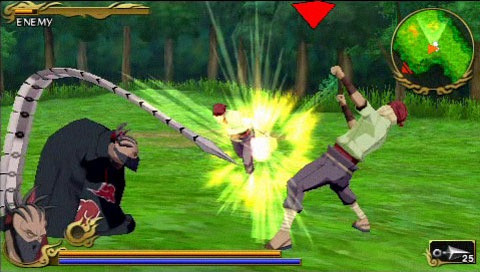
Like any decent brawler from the old days, Naruto Shippuden Legends: Akatsuki Rising features a cooperative mode for two players connected ad-hoc, with a versus mode for those who don't get along quite so well. It's out in the fall, and it seems to be exclusive to North America for now.
IN BRIEF: VIRTUAL ON STICKS, NEW-OLD SOUL CALIBUR: BROKEN DESTINY CHARACTERS, TINGLE RETURNS
If you've bought Virtual On: Oratorio Tangram for Xbox Live, you probably know that some are complaining about the inadequacy of the stock 360 controller. Hori is addressing the problem with a massive Twin Stick that replicates the dual-joystick Virtual On setup for the low price of $300. At that amount, Hori's only making them if enough people pre-order, and the quantities are sure to be low (National Console Support is apparently down for three of the controllers). If the hardcore players want authentic Virtual On badly enough, they shall have it.
New screens for Soul Calibur: Broken Destiny on the PSP confirmed another round of returning characters: Raphael, Setsuka, Lizardman, Cervantes, Maxi, Yun-Seong, Xianghua, and Seong Mi-na. They join Tira, Cassandra, Hilde, Voldo, Ivy, Nightmare, Algol, Mitsurugi, Astaroth, Taki, Sophitia, and Siegfried, plus the all-new Dampierre and God of War guest star Kratos. I wouldn't be surprised if Namco just throws in all of the Soul Calibur IV lineup minus the bonus characters designed by manga artists. Are they really going to have Soul Calibur without Kilik? No.
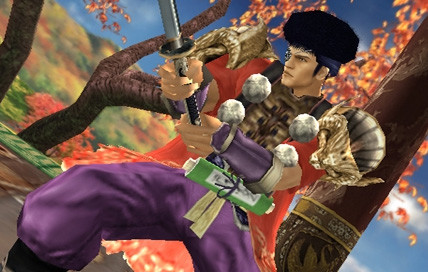
Broken Destiny's fighter-creating mode is also in effect, in case you were wondering.
Nintendo apparently thinks that North America doesn't like Tingle, the prancing, 35-year-old wannabe-fairy introduced in The Legend of Zelda: Majora's Mask and subsequently played up in The Wind Waker. His personal game, Freshly Picked Tingle's Rosy Rupeeland for the DS, skipped America entirely, showing up in Japan and Europe. Nintendo, however, isn't done with Tingle, and a new section of the company's website shows Tingle getting a player-chosen fortune. It's clearly part of a new Tingle game, one that might come here if Nintendo decides we deserve more of him.
REVIEW: SUPER ROBOT TAISEN OG SAGA: ENDLESS FRONTIER
 Developer: Monolith Soft
Developer: Monolith Soft
Publisher: Atlus
Platform: DS
MSRP: $34.99
Super Robot Taisen OG Saga: Endless Frontier is without the slightest degree of shame. I'm not sure if that's an inherently bad thing. When you're making an off-shoot of an off-shoot of Super Robot Taisen, a series marinated in unrepentant fan-pandering and graphic overkill, you can't really draw the line halfway. And that's what Endless Frontier is: an innuendo-spouting, cleavage-baring cavalcade of anime drivel that stumbles only because it runs short on the good kind of nonsense.
With little preamble, Endless Frontier joins unflappably suave bounty hunter Haken Browning (whose last name is the first of many references to the Super Robot Taisen: Original Generation series) and his split-personality android ally Aschen Brodel as they investigate the ruins of a hi-tech airship. They awaken a slumbering princess named Kaguya Nanbu, whose journey back to her kingdom leads the three of them to new dimensions and new allies. Endless Frontier tweaks the alternate-reality angle employed in the Original Generation games, encompassing worlds of animal-people, demon royalty, giant robots, and a few of Monolith Soft's other games. It's a speedy, stupid trek through stereotypes, and no one's going to play it for the narrative weight.
 Endless Frontier's tone is set in the first three minutes, when Aschen sheds half of her bodysuit and switches to a hard-partying demeanor to unlock a door. That's mild compared to Princess Kaguya, who's spilling out of her skimpy dress half the time, or Kaguya's midriff-baring oni-princess friend, Suzuka. It's enough to give KOS-MOS and T-ELOS, the lingerie-clad robots from Xenosaga, the dignity of Supreme Court Justices when they show up in Endless Frontier. Reiji and Xiaomu, the fourth-wall-breaking stars of Monolith's Namco X Capcom, also drop in to gawk at all of the bared flesh and convoluted plotting.
Endless Frontier's tone is set in the first three minutes, when Aschen sheds half of her bodysuit and switches to a hard-partying demeanor to unlock a door. That's mild compared to Princess Kaguya, who's spilling out of her skimpy dress half the time, or Kaguya's midriff-baring oni-princess friend, Suzuka. It's enough to give KOS-MOS and T-ELOS, the lingerie-clad robots from Xenosaga, the dignity of Supreme Court Justices when they show up in Endless Frontier. Reiji and Xiaomu, the fourth-wall-breaking stars of Monolith's Namco X Capcom, also drop in to gawk at all of the bared flesh and convoluted plotting.
It'd be even worse if Endless Frontier treated this titillation as matter-of-fact, but if the original writers didn't acknowledge it as a huge joke, the Atlus localizers certainly did. Instead of fecklessly wringing their hands about how horrible and embarrassing the game is, the translators mock it in the only way they can. Everything's played as deliberate camp, with puns and casual sexism flying among the cast, most of whom come off as more amusing than they have any right to be. All of the suggestive sights are remarked upon by the characters, who constantly invent unflattering nicknames for each other throughout the game. It's the game-localization equivalent of this little musical number, and it works far better than I expected. Endless Frontier still captures many all-too-true stereotypes about anime and Japanese RPGs, but it's hard not to admire the audacity of its English handlers. Of course, if you're the type whose heart sings at the notion of a sword-wielding princess jiggling with her every move, no criticism will keep you from Endless Frontier.
 Beneath the risqué attempts at comedy and the sex androids and the garter-wearing elf magicians, there is, in fact, an RPG. It's built with fairly traditional setups, though Monolith tried to cut out some of the genre's typical annoyances. In Endless Frontier, battles occur randomly but far less often than the usual J-RPG, and it's easy to run from everything but a boss encounter.
Beneath the risqué attempts at comedy and the sex androids and the garter-wearing elf magicians, there is, in fact, an RPG. It's built with fairly traditional setups, though Monolith tried to cut out some of the genre's typical annoyances. In Endless Frontier, battles occur randomly but far less often than the usual J-RPG, and it's easy to run from everything but a boss encounter.
The stage design offers only limited puzzles, as it's truly the combat itself that forms the game's core. Each of the four front-line party members unleashes combos with each press of the attack button, launching enemies in the air and bouncing them off walls.What starts off simple becomes a matter of expert timing, as players can switch from a currently attacking character to the next available one in the middle of a combo, even calling in backup characters (or robots from the Original Generation series) for quick strikes. Battles become long, rhythmic tests of button-jabbing, as keeping an enemy in the air is the best way to ensure that it won't block your attacks. Multi-character combos also fill up a special-move meter quicker than usual, letting you release extravagant streams of damage and, well, watch the game's female cast bounce around. Like Monolith wasn't going to put that in.
 In the Xenosaga series and Namco X Capcom, Monolith put together clever, potentially enjoyable battle systems that grew tedious for one reason or another. Endless Frontier might be the closest they've come to perfecting their mixture of button-pounding attacks and overlying strategy. Unlike Namco X Capcom, the battles here occasionally present some challenge, forcing players to rely on good old-fashioned item stockpiling. Mixing attacks from multiple characters leads to all sorts of experimentation for the game's first few hours, when the player's still coming to grips with the combo system.
In the Xenosaga series and Namco X Capcom, Monolith put together clever, potentially enjoyable battle systems that grew tedious for one reason or another. Endless Frontier might be the closest they've come to perfecting their mixture of button-pounding attacks and overlying strategy. Unlike Namco X Capcom, the battles here occasionally present some challenge, forcing players to rely on good old-fashioned item stockpiling. Mixing attacks from multiple characters leads to all sorts of experimentation for the game's first few hours, when the player's still coming to grips with the combo system.
Endless Frontier may show Monolith at its most accomplished, but it doesn't take its combat far enough. New attacks are unlocked as characters progress, but there comes a point, about ten hours in, when you'll have all of the cast and a good selection of moves. Your party doesn't grow beyond seven members (plus some OG mecha who can only assist from the back row), and their attacks can get repetitive. From that point on, the only draw lies in uncovering a few new combos, seeing the occasional amusing line, or finding out just how many times you can hit an enemy without letting it touch the ground. The constant cleavage shots also get repetitive. Then again, those are aimed at the people who've persistently bought minor variations on the same terrible, boobs-filled anime series for the past two decades.
 As a sign of further imbalance, Endless Frontier looks quite bland in its overhead visuals and fairly impressive during battle. The world map could pass for a TurboGrafx-16 game if not for the color palette, and the dungeons are nearly as unremarkable. In combat, however, the game shows off strikingly large sprites with lots of attack variations, and decently animated characters pop up during tag-team switches and special movies. Exposure aside, the design work ranges from standard techno-punk and anime stereotypes to amusingly elaborate creations like Haken's Swiss Army Knife of an assault rifle. The soundtrack's a synth-rocker in the vein of many hyper-manly robot shows, and Atlus left the in-battle Japanese voice acting untranslated, with no dub work at all.
As a sign of further imbalance, Endless Frontier looks quite bland in its overhead visuals and fairly impressive during battle. The world map could pass for a TurboGrafx-16 game if not for the color palette, and the dungeons are nearly as unremarkable. In combat, however, the game shows off strikingly large sprites with lots of attack variations, and decently animated characters pop up during tag-team switches and special movies. Exposure aside, the design work ranges from standard techno-punk and anime stereotypes to amusingly elaborate creations like Haken's Swiss Army Knife of an assault rifle. The soundtrack's a synth-rocker in the vein of many hyper-manly robot shows, and Atlus left the in-battle Japanese voice acting untranslated, with no dub work at all.
Endless Frontier is a preposterous, hormone-baiting charade, tolerable only if you're willing to take it as comedy. Super Robot Wars superfans will likely brush it off, as it offers no anime-derived robots and only a few of the Original Generation ones. Still, those who accept it will find an engaging battle system and a surprisingly non-irritating RPG that, sadly, goes dry a third of the way through its quest. It's dumb, it's shallow, and it's not going to blaze new trails of dignity for the world of Japanese RPGs, but there's a side of Endless Frontier that's worth playing.
RELEASES FOR THE WEEK OF 6-21
DYNASTY WARRIORS 6: EMPIRES Keep in mind that there aren't actually six Dynasty Warriors Empires games. Each Dynasty Warriors game from the fourth one on has seen an Empires spin-off focused on strategy, and the latest uses the engine from Dynasty Warriors 6. It's similar to the Xtreme Legends spin-offs for the regular Dynasty Warriors games or the Strikeforce game for the PSP or the original Dynasty Warriors, which was a 3-D fighting game and OH GOD MY BRAIN. Well, the Empires version of Dynasty Warriors 6 offers two paths. As a warlord, the player assumes a strategic role similar to that portrayed in Koei's Romance of the Three Kingdoms series, in which governance and army-building are key (they're also symbolized by cards, but hey, it's a video game). The officer's path, on the other hand, puts the player in battles inspired by the usual chaotic Dynasty Warriors combat, with the external options of advising warlords or even betraying them.
|
MONSTER HUNTER FREEDOM UNITE Developer: Capcom
Developer: Capcom Publisher: Capcom Platform:PSP MSRP: $29.99 Well, Monster Hunter, here you are again in America. Over in Japan, you're a bold new firebrand of the industry, bending subway passengers and sales charts and even national productivity to your multiplayer will. In the West, you're just a reasonably popular PSP series with a devoted niche following. That niche will doubtless want Freedom Unite, as it lets players of Monster Hunter Freedom 2 bring their characters into an another action-RPG. Aside from the various new quests and a lineup of original monsters, the most interesting new feature is a computer-controlled partner for those tired of relying on other players. Like Resident Evil 5, Freedom Unite turns the Monster Hunter franchise's catlike felyne characters into sidekicks for the player's main character, a feature that Capcom swears up and down won't screw up your fights by making partners do the exact opposite of what you want. |
RESIDENT EVIL ARCHIVES  Developer: Capcom
Developer: Capcom Publisher: Capcom Platform: Wii MSRP: $29.99 For those who own no current systems but the Wii and want Resident Evil 5, you can take comfort in getting, well, the GameCube remake of Resident Evil. It's called Resident Evil Archives and it sports some basic Wii remote control, but it's basically the same Resident Evil that came out for the GameCube years ago (and actually runs on a Wii just fine). Just in case you've never played Resident Evil, the Gamecube version was a pretty, easily playable revamp of the game that kick-started “survival horror” back in 1996. While the zombie-filled mansion feels confined now, it's still an enjoyable trek through gruesome, awkward combat and untaxing puzzle solving. It's probably not worth another $30, though.
|
SHIN MEGAMI TENSEI: DEVIL SURVIVOR  Developer: Atlus
Developer: Atlus Publisher: Atlus Platform: DS MSRP: $29.99 When Devil Survivor was first announced, Shin Megami Tensei fans complained long and loud about Suzuhito Yasuda providing the character art instead of longtime SMT illustrator Kazuma Kaneko. I was getting a little tired of seeing Kaneko's art in every single Shin Megami Tensei game myself, but Yasuda's work is the same simple, stock-anime style he used in his Yozakura Quartet manga. That aside, Devil Survivor breaks some interesting new ground for the franchise, as it adapts demon alliances, character relationships, and other SMT traditions to the battle grids of a strategy-RPG. The game's already been compared to Square's The World Ends With You, due to a visual style that finds lanky teenagers stranded in a gloomy stretch of Tokyo, sealed off by the government because of demon outbreaks. Those demons, by the way, are still designed by Kaneko. |
EXTRA LIVES: TROUBLE SHOOTER
 In the last installment of this feature, I wrote about the Dirty Pair: Project Eden game for the Famicom Disk System. I hated it. To wash away that unpleasant taste, I went looking for a better Dirty Pair game, only to find that there isn't one. So I'm going with a pair of Sega Genesis shooters that, in my opinion, brought the Dirty Pair style to video games better than anything else.
In the last installment of this feature, I wrote about the Dirty Pair: Project Eden game for the Famicom Disk System. I hated it. To wash away that unpleasant taste, I went looking for a better Dirty Pair game, only to find that there isn't one. So I'm going with a pair of Sega Genesis shooters that, in my opinion, brought the Dirty Pair style to video games better than anything else.
Shooters were in no short supply on the Genesis by 1991, and most of them followed the same instructions: stick a spaceship or a biplane or a flying horse in stages full of cunningly targeted enemy fire, and there you were. Vic Tokai and Seibu Lease's Trouble Shooter (Battle Mania in Japan) aimed elsewhere. It took the idea behind Capcom's Forgotten Worlds, in which two manly soldiers of the future floated around while firing, and filled it with the same concept that drove the Dirty Pair's most striking moments: two anime women tear through skies and cities, leaving a trail of half-comical destruction in their wake. Trouble Shooter's duo isn't quite as evenly partnered as Kei and Yuri, though. The blonde, often exasperated Madison (Mania Ohtorii in Japan) is the star of the show, and the blue-haired, more easygoing Crystal (Maria Waneda) is her sidekick.
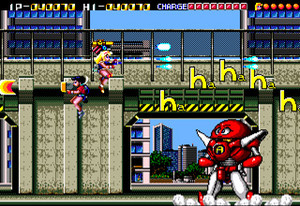 Dispatched to rescue a young prince from a terrorist leader named Blackball, Madison and Crystal don jet packs and grab one of four remote satellites. The player controls Madison, with Crystal hefting a rocket launcher and shadowing her friend's movement. Madison can only fire straight ahead, but a tap of a button flips Crystal's aim forwards or backwards, creating some helpful rear-firing angles. All the while, their satellite builds up a power meter that, when full, launches a screen-clearing bomb at the player's discretion.
Dispatched to rescue a young prince from a terrorist leader named Blackball, Madison and Crystal don jet packs and grab one of four remote satellites. The player controls Madison, with Crystal hefting a rocket launcher and shadowing her friend's movement. Madison can only fire straight ahead, but a tap of a button flips Crystal's aim forwards or backwards, creating some helpful rear-firing angles. All the while, their satellite builds up a power meter that, when full, launches a screen-clearing bomb at the player's discretion.
Trouble Shooter saw some favorable reviews back in 1991, including a line of super-excited red smiley faces from GamePro, and yet it never caught on that well with devoted shooter fans. That's fair enough, as it's a flawed game. The visuals are solid for a second-generation Genesis outing, but the large characters come at a price. While only Madison takes damage, she's still a big target, and the game often throws her and Crystal down tight passages, scrolling both horizontally and vertically, that require some memorization on the player's part. Madison's also stuck with the same weapon throughout the game, and upgrading it just fires more of the same shots.
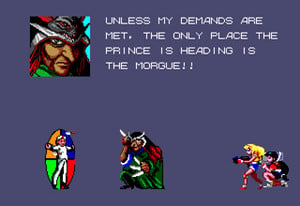 If it isn't an intense trailblazer, Trouble Shooter at least has some personality. From the opening shot of Madison and Crystal knocking over the Sega logo, the game's immersed in the weird Japan pop-humor that crested in anime during the late 1980s, with some corny American scripting thrown in. The bosses include a laughing robot and a huge mechanical cyclist, while the game's apparent ending suddenly gives way to a last-ditch fight between Madison, her own clone, and Blackball's monstrous final form. Another surprise comes when our heroines finally rescue the prince. Instead of sidelining him for his own safety, the game gives him a blaster and a jetpack and turns him into another semi-controllable character.
If it isn't an intense trailblazer, Trouble Shooter at least has some personality. From the opening shot of Madison and Crystal knocking over the Sega logo, the game's immersed in the weird Japan pop-humor that crested in anime during the late 1980s, with some corny American scripting thrown in. The bosses include a laughing robot and a huge mechanical cyclist, while the game's apparent ending suddenly gives way to a last-ditch fight between Madison, her own clone, and Blackball's monstrous final form. Another surprise comes when our heroines finally rescue the prince. Instead of sidelining him for his own safety, the game gives him a blaster and a jetpack and turns him into another semi-controllable character.
In between the parody-flavored gameplay, the characters spout dialogue apparently provided by the same people who localized Vic Tokai's Secret Ties. The kidnapped Prince talks like a Ninja Turtles fan, Blackball drops threats like a Saturday morning cartoon villain, and Madison cynically rails against chauvinism shortly before she considers shopping during the game's downtown stage (Women, I tells ya! Hyuck!). Hokey as it all is, the conversations give Trouble Shooter a flavor far more memorable than the typical straight-faced shooter, and, unlike just about every other Japanese-made Genesis game translated by a second-string publisher, there's no Engrish to be seen.
 Trouble Shooter's success in America was marginal, if Vic Tokai's treatment of the sequel was any indication. Released in Japan as Battle Mania Dai Gin Joh in 1993, it earned little attention from domestic magazines (some of whom preemptively branded it Trouble Shooter 2) and faded from sight quickly. It was an injustice, as this Trouble Shooter sequel improves vastly on the original. The visuals are sharper, the levels demand more acute reflexes, and, best of all, Madison can fire conveniently in eight directions. Crystal still shadows her alongside a remote bomb, but it's far more easy to maneuver them.
Trouble Shooter's success in America was marginal, if Vic Tokai's treatment of the sequel was any indication. Released in Japan as Battle Mania Dai Gin Joh in 1993, it earned little attention from domestic magazines (some of whom preemptively branded it Trouble Shooter 2) and faded from sight quickly. It was an injustice, as this Trouble Shooter sequel improves vastly on the original. The visuals are sharper, the levels demand more acute reflexes, and, best of all, Madison can fire conveniently in eight directions. Crystal still shadows her alongside a remote bomb, but it's far more easy to maneuver them.
Battle Mania Dai Gin Joh also pushes the first Trouble Shooter's mockery to proud new extremes. The first level brings back the original game's bosses for an amusing fakeout, a dive through a hi-tech enemy base terminates with a showdown inside a giant UFO catcher, cape-wearing Mario facsimiles attack in another stage, and the final boss ties Crystal to a cross (symbolism!). There's even a strange opening shot of a Japanese TV clock ticking up to the hour. The cutscenes are improved with better artwork, as Madison and Crystal quibble over money and vacations during the levels. Lastly, the soundtrack, which was largely forgettable in Trouble Shooter, is remade into a catchy wonder that overdrives the Genesis sound hardware throughout Battle Mania Dai Gin Joh. It's always impressive when a developer creates sound effects for spent machine-gun shells that clatter across a title screen.
 In 1993, the Battle Mania series showed signs of becoming something amazing in its third game. This, of course, meant that Vic Tokai and Seibu Lease wouldn't make one. The development team, identified as Studio Space Iron Men, never again put that name on another project, suggesting that they were internal Vic Tokai and Seibu Lease staffers who devised Trouble Shooter as a pet project. In the U.S., Vic Tokai decided to back an annoying Sonic the Hedgehog rip-off called Socket instead of another Trouble Shooter, and from there continued a company-wide descent into irrelevance.
In 1993, the Battle Mania series showed signs of becoming something amazing in its third game. This, of course, meant that Vic Tokai and Seibu Lease wouldn't make one. The development team, identified as Studio Space Iron Men, never again put that name on another project, suggesting that they were internal Vic Tokai and Seibu Lease staffers who devised Trouble Shooter as a pet project. In the U.S., Vic Tokai decided to back an annoying Sonic the Hedgehog rip-off called Socket instead of another Trouble Shooter, and from there continued a company-wide descent into irrelevance.
The two Trouble Shooter games have their fans today, even if they're not the sort of tightly programmed shooters that drive score-obsessed followers to psychosis. Trouble Shooter's just a lightweight ride through anime-esque comedy, and the sequel's just a solid action game, suggesting that a third Trouble Shooter could've been a true classic. Although that never came to pass, Trouble Shooter still makes its mark.
The North American version of Trouble Shooter sells for about twenty bucks, making it only slightly more expensive than other Genesis games. In Japan, it's far more rare, with the original Battle Mania typically nearing $75 and Battle Mania Dai Gin Joh going for about twice that. Vic Tokai could've saved people some money by releasing the second one here, but I suppose I've complained enough about that already.
discuss this in the forum (31 posts) |
this article has been modified since it was originally posted; see change history
 Developer: Koei/Omega Force
Developer: Koei/Omega Force